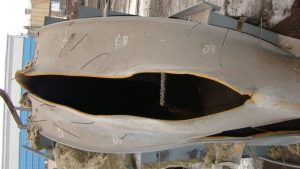Machine damage
The machine damage is processed and clarified in technical expert opinions for “machines, industrial equipment and components” against different backgrounds.

Damage to machinery and industrial equipment
Damage is a common problem in various manufacturing industries. Detailed investigations and assessments are required to settle these claims. A critical step in this process is identifying values and clarifying technical accountability. This is often done with the help of publicly appointed and sworn experts and surveyors who can be trusted for their expertise and impartiality.
Overview
Numerous examples of a wide variety of damage are presented in the images below. Damage can take many forms and shapes in industry. Handling and settling such claims requires deep technical knowledge and expertise, as the claims are often unique. Nevertheless, through appropriate experience, there are established processes and procedures for claims handling which, due to their structured approach, help to solve the problems.
Machine damages - What now?
Expert opinions on machine damages concern, for example:
The damage always indicates the failure or impairment of a machine or technical system. Machine damage can take many forms and often has a significant impact on efficiency, productivity and safety. They can affect different system components and have a wide variety of causes. Common causes are wear and tear, insufficient maintenance, material defects or human error.
In the area of claims handling for machinery damage, especially in the context of mechanical engineering and industrial equipment, numerous steps are required to ensure comprehensive and accurate claims investigation and settlement. Depending on the nature and extent of the damage, as well as the commissioning by the parties involved, the following aspects may be included in the process
-
Determining the cause of the damage: The first and crucial step is to identify the exact cause of the damage. This requires a thorough investigation. Accurate determination of the cause is critical to initiating appropriate remedial action and preventing future damage.
-
Determination of values: After the cause has been determined, it is important to establish the values associated with the damage. This includes current value, replacement value (if applicable), insured value, and possibly other metrics. These values are usually used as a basis for claims settlement.
-
Amount of damages in liability cases: In cases where liability exists on the merits, the amount of damages must be determined. This requires a detailed investigation of the damage caused.
-
Identification of remedial measures: Depending on the nature and extent of the damage, it may be necessary to identify appropriate remedial actions.
-
Amount of damage: The exact amount of damage must be determined. This includes consideration of direct damage costs as well as possible indirect costs, such as production losses and business interruptions.
-
Claims Management: Effective management of the claims process is critical to efficiently handling a claim. .
-
Checking recourse: In some cases, it may be possible to check recourse claims against third parties who could be responsible for the damage.
-
Economic viability check of a repair (“economic total loss”): In the case of severe damage, the question is often raised as to whether a repair is economically justifiable or whether it makes more sense to regard the machine or plant concerned as a total economic loss and replace it with a new one. This decision requires careful economic analysis.
Claims handling in the field of mechanical engineering and industrial equipment is an extremely complex process that requires experienced experts.
Important:
In the case of damage to machinery, the technical part of the claims processing with the determination of the cause of the damage and the responsibility for it cannot, as a rule, be separated from the assessment / value determination in the technical claim. Finally, the amount of damage is also of interest for settlement by the insurer or also in order to claim recourse or to check the cost-effectiveness of a repair.
